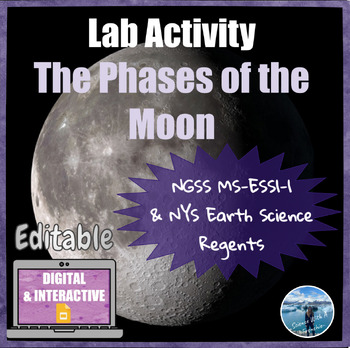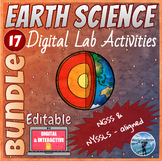The Phases of the Moon | Digital Lab Activity | Editable | NGSS
- PDF
- Google Apps™

What educators are saying
Also included in
- These digital Earth and Space Science lab activities are ideal for topics where hands-on lab activities may be difficult to complete. They are aligned with NGSS and the New York State (NYS) Earth Science curriculum to prepare the students for the Regents exam. All the labs are editable and interactiPrice $43.50Original Price $57.50Save $14.00
Description
the students will investigate the actual and apparent motions of the Moon and determine the different phases of the Moon as it moves throughout our sky over a month. First, they will observe the cycle of phases phenomenon over a month to spark their curiosity. Then, they will use an online simulation to analyze the position of the Earth, Sun, and Moon as viewed from space and by an observer on Earth for different phases of the Moon. This is an interactive lab activity with a link to an online simulation and drag & drop features.
ESL Strategies: This lab activity is scaffolded for English Language Learners (ELLs):
- Each slide contains a “Translate” hyperlink button to translate the text into any language supported by Google Translate.
- It includes sentence starters to help ELLs structure their answers. The document is editable so you can remove the sentence starters if your students don’t need them.
- You can also use these Science Question Starters for ELLs to help your students formulate their questions.
Editable: You can edit the text of this lab activity by clicking on “View” → “Theme Builder”. However, due to Term of Use agreements with clip art artists, some of the background images aren’t editable.
Digital: This digital lab activity was created with Google Slide™. It can be used in person or for distance learning. Share the Google Slides with your students via your Google Classroom. Make sure you select “Make a Copy for Each Student” while you are creating the assignment.
You may also be interested in the following astronomy notes and lab activities:
- The Moon & its Effects on Tides - Digital Lab Activity
- The Earth-Sun-Moon System - Notes & Workbook
- Life Cycle of Stars - Digital Lab Activity
- The Doppler Effect - Evidence for the Big Bang Theory - Digital Lab Activity
- Terrestrial vs. Jovian Planets - Digital Lab Activity
- NYS Earth Science Digital Lab Activities - Growing Bundle
⭐ My store is new, follow me for notifications about new resources coming soon! ⭐






